Installing heating batteries: do-it-yourself technology for the correct installation of radiators
A variety of heating systems provide comfortable indoor air temperature. The basis of the vast majority of heating concepts is made up of special heat transfer devices, in everyday life called batteries. You can install them yourself, if you know the nuances of work.
We have collected and systematized for you all the information about the options and connection methods. Based on our recommendations, the installation of heating radiators with their own hands will be carried out without the slightest difficulty. All readers of our article will cope with it without problems.
A detailed description of the options and connection technologies is supplemented by visual schemes, photo collections, video instructions.
The content of the article:
Heating parameters for selecting appliances
Understanding what battery designs are needed will help with initial knowledge of the modes and conditions of operation of heating appliances.
The following is a summary of information on important parameters of heating systems when choosing batteries:
1. Internal pressure. The value required for the correct choice of a device capable of withstanding the pressure in the heating circuit:
- Private house (autonomous) = 1.5-2 atm.
- Private house (centralized) = 2-4 atm.
- 5-storey house (centralized and autonomous) = 2-4 atm.
- 9-storey building (centralized and autonomous) = 5-7 atm.
- House over 9 floors (autonomous) = 5-7 atm.
- House over 9 floors (centralized) = 7-10 atm.
If the technical capabilities of the battery are lower pressure in the heating circuit, there is a possibility of depressurization of the device with other negative consequences.
2.Permissible heating temperature. A characteristic indicating the upper temperature limit, above which the battery may fail:
- Autonomous = up to 90⁰С.
- Centralized with wiring made of plastic = up to 90⁰С.
- Centralized with steel wiring = up to 95 ° C.
Operation in violation of the temperature conditions leads to the melting of seals, deformation and loss of tightness of the device.
3. The degree of contamination of the coolant. A parameter that is mainly interested in owners autonomous heating systems and water supply:
- Autonomous private house = high, medium, low when installing filters.
- Autonomous multi-storey building = high, medium, short when installing a filter system.
- Centralized = low, in rare cases medium.
Water supplied by centralized networks to communal heating systems is undergoing a comprehensive treatment. The content of sand and clay suspensions in the water extracted from private wells, wells, open sources, may exceed the permissible limit.
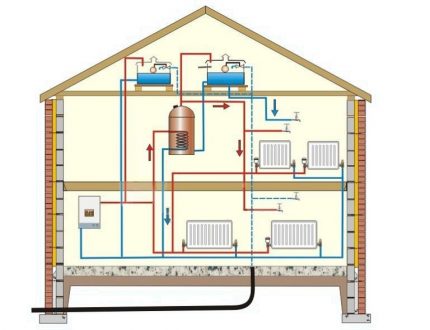
Traditional battery locations
For further selection of battery designs, you need to determine the points installation of heating appliances. Place them in places of the greatest penetration of cold. This is done to minimize the effect of drafts on the indoor climate. They also focus on ensuring availability for the purpose of periodic maintenance.
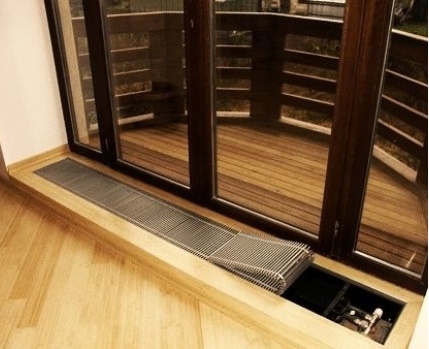
Battery Location Zones:
- Window sills. The most common place is the location of heating appliances.
- Extended window spaces. One of the popular extras.
- Corners and “blind” walls of corner rooms. It is used to enhance the heating of rooms with increased heat loss due to the intense influence of winds.
- Bathrooms, pantries, bathrooms, one or two sides of which are combined with the main bearing wall.
- Unheated entrances, hallways of private houses.
- Apartment corridors of the first floors of high-rise buildings.
Modern versions of heating appliances fit under a balcony door or entrance to the loggia.
An example of the location of heating radiators in one house:
Design specifics of heating appliances
Structurally, the batteries are divided into groups, these are radiators, convectors and registers.
Overview of popular heating appliances
A radiator is the most common type. This is a heating device consisting of separate vertical compartments sections. In classic collapsible products, sections are independent working elements. They are joined in the required quantity using threaded internal connections. This assembly pattern gives the battery versatility.
Before installing, it is possible to complete the radiator, it is required perform calculation in accordance with the necessary heat output. According to the calculations, the number of sections of prefabricated batteries is selected. The horizontal radiator cavities obtained by connecting the sections are called collectors. Top and bottom.
Modern technologies have mastered the manufacture of less universal, but more reliable non-separable radiators using welding and solid casting methods. They do not have joints and seals characteristic of collapsible radiators. Design for every taste.
A convector is an integral heating device made of a tubular or cavity heat exchanger with rows of heat-removing fins. Convectors are available in the following versions:
- Wall mounted.
- Floor (channel)
- Skirting boards.
Register - a non-separable heating device from straight smooth horizontal pipes arranged and combined in a certain way.
Details about the types of radiators
Radiators differ in the material used for their manufacture.
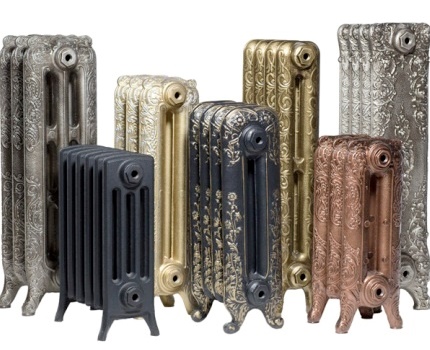
The market for heating appliances can offer:
- Cast iron radiators. The ancestors of the batteries in this group. Relatively inexpensive. Withstand each of the operating modes. Serve up to 50 years. The main disadvantage is that they have a lot of weight, which, however, helps to retain heat for a long time when the heating is turned off.
- Steel radiators. Such batteries are steel pipe structures. They work in any conditions, but less durable cast iron counterparts. They have low heat dissipation.
- Radiators are aluminum. Made of lightweight, aesthetic material, these batteries give out the best heat. They are resistant to all operating temperatures, but are afraid of water hammer. Aluminum is very demanding on the quality of the coolant.
- Bimetallic radiators. Steel internals clad in aluminum - that says it all. The main characteristics, like steel ones, heat transfer is almost like that of aluminum. The price is biting.
- Copper radiators. These are “eternal” heat radiators for any premises. Their only and most significant minus is the ultra-high cost.
- Plastic radiators. Innovation in the radiator family. So far, they are suitable only for autonomous heating systems of private houses with a coolant heated to not more than 80 ° C.
The most sensitive to operating conditions aluminum appliances. These radiators have reliably served only 15 years. Their use is possible only in autonomous heating systems.
Externally popular models of radiators from different materials are similar:
Characterization of convector variety
Convectors are significantly inferior in heat transfer to radiators, but in some cases they successfully supplement or replace them:
1. Wall convectors. The batteries in this design are usually made of steel, so they are cheap. They are unstable to water hammer, and their use in centralized heating systems is undesirable.
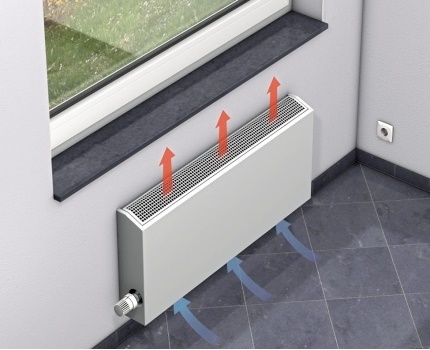
But made in the form of pipes bristling with plates - such batteries are suitable only for installation in utility rooms.
2. Floor convectors (channel). An excellent solution for creating a thermal curtain at the doors of a balcony or loggia. Made of durable corrosion-resistant materials, they are unpretentious to the requirements of operation.
3. Skirting convectors. Able to work in all conditions and modes, these batteries are the best suited for creating a microclimate where all other heaters will look bulky.
Skirting type is appropriate in bathrooms and pantries, adjacent to cold street walls and unheated porches.
Short description of heating registers
Once the batteries of this group were made artificially using conventional welding. Registers can be used in any heating systems, but because of their unpretentious appearance they are used mainly in auxiliary rooms: garages, pantries, basements. Sometimes they can be seen in the hallways of old high-rise buildings.
Modern manufacturers have "laid eyes" on this group of heating appliances.
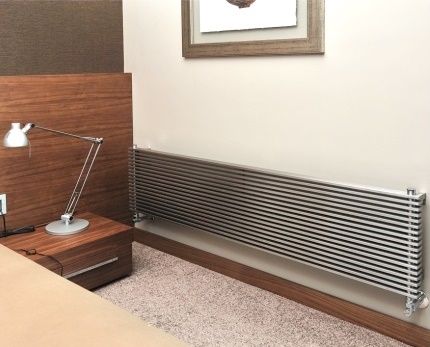
Calculation of thermal power of batteries
The pre-selection phase of the batteries is completed, you can proceed to the calculation of the required thermal power from them. The calculation is based on a relative power of 100 W for heating 1 m² of a standard room.
The full formula includes many correction factors and looks like this:
Q = (100 x S) x R x K x U x T x H x W x G x X x Y x Z,
Where:
S = area of the heated room, where:
R - an additional parameter for rooms oriented east or north = 1.1;
K - correction for the presence of external walls in the room:
one = 1.0;
two = 1.2;
three = 1.3;
four = 1.4;
U - coefficient of insulation of street walls:
low = 1.27 (without insulation);
average = 1.0 (plaster, surface insulation);
high = 0.85 (insulation made according to special calculations);
T - weather indicator of the period of the lowest temperatures in ⁰С:
up to -10 = 0.7;
to -15 = 0.9;
to -20 = 1.0;
to -25 = 1.1;
to -35 = 1.3;
below -35 = 1.5;
H - ceiling height index in meters:
up to 2.7 = 1.0;
up to 3 = 1.05;
up to 3.5 = 1.1;
up to 4 = 1.15;
W - characteristics of the premises located on the floor above:
unheated and uninsulated = 1.0 (cold attic);
unheated, but insulated = 0.9 (attic with insulated roof);
heated = 0.8.
G - the degree of quality of the windows:
serial wooden frames = 1.27;
single-pane frames with glass = 1,0;
double glazed frames = 0.85;
X - the ratio of the area of window openings to the area of the room:
up to 0.1 = 0.8;
up to 0.2 = 0.9;
up to 0.3 = 1.0;
up to 0.4 = 1.1;
up to 0.5 = 1.2;
Y - the value of the openness of the surface of the batteries:
fully open = 0.9;
covered with a window sill = 1,0;
blocked by a horizontal ledge of the wall = 1.07;
covered with a window sill and a frontal casing = 1.12;
barred from all sides = 1.2;
Z - battery connection efficiency (1.0 ÷ 1.13; for details, see the section below).
The calculated value must be multiplied by a conditional coefficient of 1.15. It will provide a certain amount of heat to enable more accurate adjustment of devices to work in low temperature mode.
Effective Connectivity
Before continuing to learn how to choose, install, and connect heating radiators and other heating appliances, it is necessary to consider two main types of wiring pipes of existing heating systems. They differ in the principles of organizing the supply of coolant into the batteries and returning it to the system.
In practice, a pipe supplying heat is referred to as a “supply”. The pipe returning the coolant is a "return". The vertical wiring pipe (feed or return) is called a “riser”.
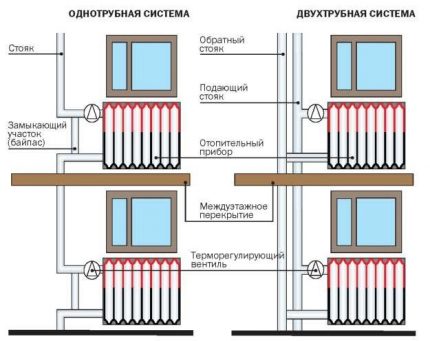
Traditional wiring options:
- Single tube. The wiring is designed so that the role of supply and return is played by one pipe. Batteries "crash" into it sequentially. The coolant bypasses the heating devices in the order they are connected.
- Two-pipe. In a two-pipe wiring, one pipe is the feed, the other is the return. With this option, the radiators of the battery are connected simultaneously to both pipes, parallel to each other. The coolant circulates through all the batteries at the same time.
The coefficient “Z” in the formula for calculating thermal power depends on the options for connecting heating devices.
The most widely used in practice connection methods:
Method number 1. Diagonally. Z = 1.0.
This connection procedure is the most effective, especially if the heating system does not work well. The coolant enters the battery from one side from above, passes through the entire internal cavity and leaves the bottom from the other side.
Thermal energy is transferred to the entire surface of the heater. For radiators longer than 12 sections, this method is highly recommended.
Method number 2. On the side (top - entrance, bottom - exit). Z = 1.03.
Until recently, the most common method of connecting batteries. It is convenient for installation due to the small length of the connections.
For radiators up to 12 sections, almost inferior in heat transfer to the diagonal connection method. But this is in debugged existing heating systems. If the systems are functioning sluggishly, the hot coolant will not reach the end compartments of the radiators.
Method number 3. Bottom on both sides. Z = 1.13.
Despite the least efficiency, this method of connection quickly took root in new construction, thanks to plastic pipes. Wiring of heating systems are mounted in the floor, and do not overshadow the design of the premises. With properly configured heating systems, all parts of the batteries receive uniform heating.
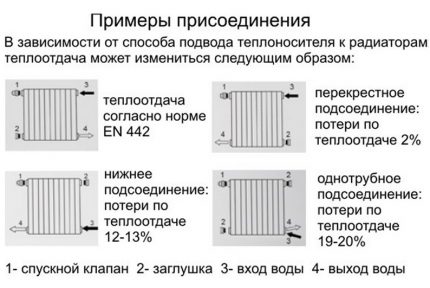
The final step in battery selection
The final stage of selection is based on the results obtained of the capacities required from heating devices.
Ready-made integral designs of radiators, convectors or registers are selected at the time of purchase.
From the factory passports of the products, data on their thermal capacity is visible. When purchasing batteries, the particularities of the installation site (for example, the possible dimensions of the device) are taken into account.
Special organizations produce fixed radiators and registers with individual parameters on request. Collapsible radiators should be looked after by the number of sections, based on their total thermal power.
Approximate individual capacities of standard 500 mm sections of different materials (watts with a coolant of 70 ° C):
• Cast iron = 160;
• Steel tubular = 85;
• Aluminum = 200;
• Bimetal = 180.
The power of collapsible radiators is regulated by attaching additional or disconnecting redundant sections.
When choosing batteries of various designs for one room, it is more correct to start their selection with non-separable products.
General tips for installing batteries of different groups
It is recommended to use appliances equipped with automatic and mechanical air vents. For other designs of heaters - the extreme upper point on the side opposite to the coolant inlet.
It is also proposed to install a heat-reflecting screen between the battery and the outer wall. For its manufacture, you can pay attention to modern heat-reflecting materials isospan, penofol, alufom.
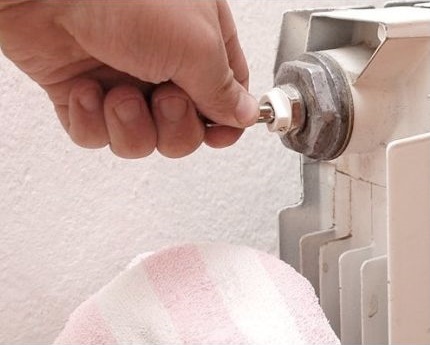
When fixing the heaters in place, they are not allowed to deviate from the horizontal level. It is allowed to raise the side with the air vent to 1 cm for better air collection and release.
When connecting heating appliances to systems with risers, the centers of the battery inlet openings must be no higher than the centers of the outlets from the supply pipes. If, when connecting to the risers, it is supposed to equip the heating units with taps or devices for adjusting the temperature, in single-pipe heating systems installation of bypasses in their absence.
Bypass is a jumper parallel to connecting the battery. This element allows you to organize the control of the heater. It is a piece of pipe connecting the input and output of the battery. The diameter of the jumper pipe should be one size smaller than that of the riser pipe. In two-pipe heating systems, bypass installation is not required.
Due to the very different expansion coefficients of the materials, it is not recommended to connect the batteries with plastic wiring to the wiring of steel pipes. Conversely, the main plastic wiring eliminates the transition to steel parts of the connection.
Until the installation is completed, it is advisable not to remove the packaging shell from the steel, aluminum and bimetallic batteries in order to avoid mechanical damage.
Preparation of collapsible radiators for installation
If the purchased collapsible batteries do not have the calculated parameters, they should be finalized by disconnecting the extra sections or adding to the desired amount. Between each other, the radiator compartments are pulled together with plumbing nipples through round gaskets.
Nipple is a short thick-walled tube with an external thread. Half right, half left. Inside the tube along the entire length are two opposing longitudinal technological protrusions.
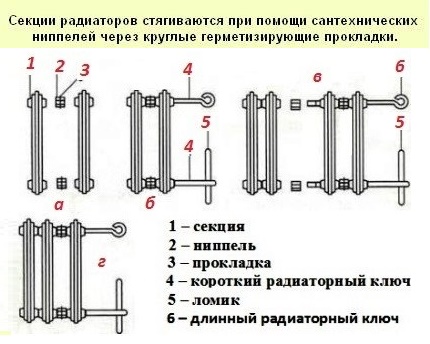
The radiator wrench can be replaced with a chisel of a suitable length, with a sting width sufficient to securely engage the nipple protrusions. The role of the collar will play an adjustable pipe wrench.
The design of a collapsible radiator has a left-hand thread.
To correctly perceive the direction of rotation, it is recommended to unscrew or twist the nipples by inserting a key or chisel into the holes of the sections where the thread is right. To avoid distortions of the parts, the holes must be alternated through a revolution of another tool.
Fixing collapsible radiators in place
Collapsible radiators are hung on special brackets. The most reliable arc-shaped hooks mounted in the main walls of the premises. In this case, the distances should be provided:
• from the floor = 6-12 cm, sufficient for cleaning and heating the bottom of the wall,
• at least 7 cm to the windowsill to ensure effective convection,
• from a heat-reflecting screen or from a wall = 3-5 cm.
The brackets are mounted in such a way as to fall into the intersectional space of the radiators. According to an unwritten rule, when plugging in batteries, end plugs with right-hand thread should be on the right, with left-hand thread on the left.
The marking for hooks is performed in the following order:
- A vertical line is drawn of the axial center of the radiator (when installing the battery under the window, most often it is its center) with a length not less than the height of the battery.
- The distance between the spaces of the first-second section of the radiator and the last-penultimate is measured.
- A horizontal line is drawn corresponding to the center of the upper radiator collector with a length of not less than the measured distance (taking into account the general tips outlined above).
- The distance itself is laid left and right on the drawn horizontal line symmetrically with respect to the center line. The resulting two points are places for the upper hooks. They will hold the weight of the structure.
- From the point of intersection of the horizontal lines and the axial center, a distance equal to the center-to-center distance of the collectors (standard is 500 mm) is laid down.
- A horizontal line is drawn through the intended point, corresponding to the center of the lower radiator collector.
- The distance measured in paragraph 2 is laid left-right on the drawn horizontal line symmetrically with respect to the center-axis line. The resulting two points are places for the lower hooks. They will ensure the stillness of the structure.
- At the designated points, holes are drilled under the dowels, into which threaded brackets are wrapped or hooks with smooth rods are hammered.
The drilling process is described for cast iron and bimetallic heating appliances having no more than 10 sections, and aluminum radiators consisting of no more than 12 sections. If the batteries are larger in the center area, add a hook above and below.
Fixing in place of non-separable species
Brackets for installing non-separable radiators are usually included in the product package. The sequence of marking the mounting points of the brackets for mounting these batteries is described in the attached installation diagram. The procedure resembles that described for collapsible radiators.
The choice of brackets for securing convectors is diverse. It is due to the location of the heater.
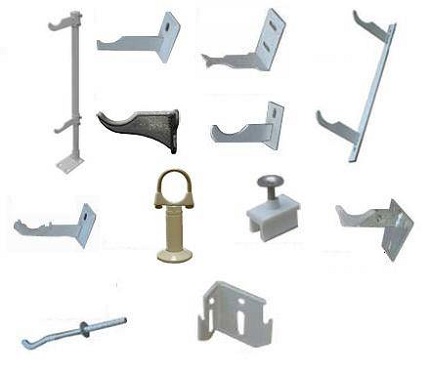
By analogy with collapsible radiators heating registers hung on arcuate hooks fixedly embedded in the walls. The total number of brackets is standardly four (two hold the upper pipe, two hold the lower). For light registers, it is possible to use holders for pipes of the corresponding diameter with clamps.
Connecting batteries to heating systems
In connection work, it is advisable to use a torque tool. The necessary tightening forces are specified in the passports of the purchased radiators. To create tightness of threaded joints, a fluoroplastic sealing material, briefly called “FUM tape”, and plumbing flax will be needed.
If the battery connections to the heating system wiring are made with plastic wiring, you will additionally need:
- Apparatus for welding polypropylene parts.
- Or crimping tool for plastic pipes.
When deciding to control the heating of batteries, taps or thermoregulators are purchased. Some prefabricated structures are immediately equipped with built-in thermostats.
The required number of pipes for the supply, the complete set with connecting parts (fittings) depend on the options for connecting to the heating system and are clarified after fixing the batteries in place. Connection methods “diagonally”, “on the side” or “bottom on both sides” are determined at the stage of calculating the heat output of installed heaters.
One of the options for assembling and installing a non-separable radiator. The preliminary stage is the purchase of the device itself and valves.
When everything is prepared, first we attach the fittings, install the adapters, and then we hang the radiators to the wall under the window according to the following scheme:
Having figured out how to correctly install a heating radiator, you can safely begin responsible work. Before installing the devices, their locations must be repaired and plastered.
You can learn about how to replace heating appliances from another popular article our site.
Conclusions and useful video on the topic
The video demonstrates the connection options:
Video tutorial on installing radiators:
The specifics of tying batteries with polypropylene:
It is deeply believed that the knowledge obtained from the article will make the installation of any design of a heating radiator, convector, or register with your own hands accessible to any owner. The main thing in the upcoming work is exceptional attentiveness and responsibility at every step of the task.
Write about how you or the plumbers installed batteries in your house / apartment. Share whether you are satisfied with the operation of the devices. Please comment in the box below. Here you can ask questions and provide useful information.

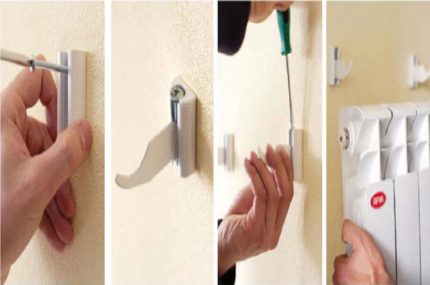
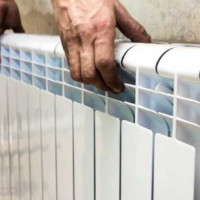 Replacing heating radiators: a guide for dismantling old batteries and installing new appliances
Replacing heating radiators: a guide for dismantling old batteries and installing new appliances 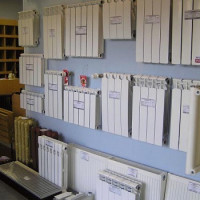 Calculation of heating radiators: how to calculate the required number and power of batteries
Calculation of heating radiators: how to calculate the required number and power of batteries 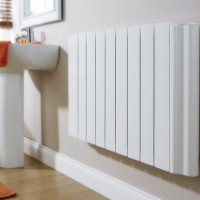 Vacuum heating radiators: overview of types, selection rules + installation technology
Vacuum heating radiators: overview of types, selection rules + installation technology 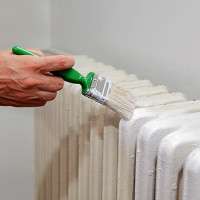 How to paint a heating battery: step-by-step technology for painting radiators
How to paint a heating battery: step-by-step technology for painting radiators 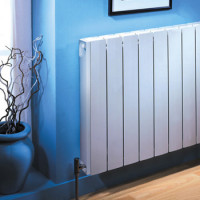 Wiring diagrams for radiators: an overview of the best ways
Wiring diagrams for radiators: an overview of the best ways  How much does it cost to connect gas to a private house: the price of organizing gas supply
How much does it cost to connect gas to a private house: the price of organizing gas supply  The best washing machines with dryer: model rating and customer tips
The best washing machines with dryer: model rating and customer tips  What is the color temperature of light and the nuances of choosing the temperature of the lamps to suit your needs
What is the color temperature of light and the nuances of choosing the temperature of the lamps to suit your needs  Replacement of a geyser in an apartment: replacement paperwork + basic norms and requirements
Replacement of a geyser in an apartment: replacement paperwork + basic norms and requirements
I can tell from my own experience, if you do not understand this, then do not get involved. This is what happened in my life. I read articles, seemed to have decided on everything what and how to do it right, consulted with a friend who was engaged in this, and he told me that without me, this could not be done. And it seemed to me that everything is simple. The pipes in the house are old and I did not think to clean them properly, after installation I plugged the “riser” with plaster, and in the winter we all froze. Never close batteries.
Hello. Drywall has a fairly low thermal conductivity and batteries should not be sealed with it, of course. Especially for putty and finish. And if you really want to cover engineering systems with something, then it would be better if it would be lattice structures or removable and always with technological hatches in order to get to the nodes in time and be able to control them.
The choice of radiator size directly depends on the dimensions of the heated room. When repairing the heating network, it is also important to replace the old radiators, since during the operation dirt accumulates in the devices and rust settles on the walls.Pollution impedes the flow of water, as a result, it can disrupt the work and reduce the efficiency of the heating system. I purchased radiators of the same brand so that there would be no problems. The air vent is also a very useful thing. If you used to wait for the neighbors on the top floor to discharge air in the system, now you can do it yourself.